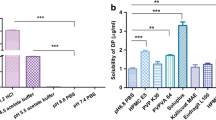Abstract
Purpose
To investigate the ability of various polymers to inhibit the crystallization of amorphous felodipine from amorphous molecular dispersions in the presence of absorbed moisture.
Methods
Spin coated films of felodipine with poly(vinylpyrrolidone) (PVP), hydroxypropylmethylcellulose acetate succinate (HPMCAS) and hydroxypropylmethylcellulose (HPMC) were exposed to different storage relative humidities and nucleation rates were measured using polarized light microscopy. Solid dispersions were further characterized using differential scanning calorimetry, infrared spectroscopy and gravimetric measurement of water vapor sorption.
Results
It was found that the polymer additive reduced nucleation rates whereas absorbed water enhanced the nucleation rate as anticipated. When both polymer and water were present, nucleation rates were reduced relative to those of the pure amorphous drug stored at the same relative humidity, despite the fact that the polymer containing systems absorbed more water. Differences between the stabilizing abilities of the various polymers were observed and these were explained by the variations in the moisture contents of the solid dispersions caused by the different hygroscopicities of the component polymers. No correlations could be drawn between nucleation rates and the glass transition temperature (T g) of the system. PVP containing solid dispersions appeared to undergo molecular level changes on exposure to moisture which may be indicative of phase separation.
Conclusions
In conclusion, it was found that for a given storage relative humidity, although the addition of a polymer increases the moisture content of the system relative to that of the pure amorphous drug, the crystallization tendency was still reduced.












Similar content being viewed by others
References
W. L. Chiou and S. Riegelman. Pharmaceutical applications of solid dispersion systems. J. Pharm. Sci. 60:1281–1302 (1971).
J. L. Ford. The current status of solid dispersions. Pharm. Acta Helv. 61:69–88 (1986).
A. T. M. Serajuddin. Solid dispersions of poorly water-soluble drugs: early promises, subsequent problems and recent breakthroughs. J. Pharm. Sci. 88:1058–1066 (1999).
C. Leuner and J. Dressman. Improving drug solubility for oral delivery using solid dispersions. Eur. J. Pharm. Biopharm. 50:47–60 (2000).
M. Yoshioka, B. C. Hancock, and G. Zografi. Inhibition of indomethacin crystallization in poly(vinylpyrrolidone). J. Pharm. Sci. 84:983–986 (1995).
L. S. Taylor and G. Zografi. Spectroscopic characterization of interactions between PVP and indomethacin in amorphous molecular dispersions. Pharm. Res. 14:1691–1698 (1997).
T. Hino and J. L. Ford. Characterization of the hydroxypropylmethylcellulose–nicontinamide binary system. Int. J. Pharm. 219:39–49 (2001).
K. Yamashita, T. Nakate, K. Okimoto, A. Ohike, Y. Tokunaga, R. Ibuki, K. Higaki, and T. Kimura. Establishment of new preparation method for solid dispersion formulation of tacrolimus. Int. J. Pharm. 267:79–91 (2003).
T. Matsumoto and G. Zografi. Physical properties of solid dispersions of indomethacin with poly(vinylpyrrolidone) and poly(vinylpyrrolidone-co-vinyl acetate) in relation to indomethacin crystallization. Pharm. Res. 16:1722–1728 (1999).
T. Miyazaki, S. Yoshioka, Y. Aso, and S. Kojima. Ability of poly(vinylpyrrolidone) and polyacrylic acid to inhibit the crystallization of amorphous acetaminophen. J. Pharm. Sci. 93:2710–2717 (2004).
H. Konno and L. S. Taylor. Influence of different polymers on the crystallization tendency of molecularly dispersed amorphous felodipine. J. Pharm. Sci. 95:2692–2705 (2006).
G. Zografi. States of water associated with solids. Drug Dev. Ind. Pharm. 14:1905–1926 (1988).
C. Ahlneck and G. Zografi. The molecular basis of moisture effects on the physical and chemical stability of drugs in the solid state. Int. J. Pharm. 62:87–95 (1990).
S. L. Shamblin and G. Zografi. The effects of absorbed water on the properties of amorphous mixtures containing sucrose. Pharm. Res. 16:1119–1124 (1999).
C. A. Oksanen and G. Zografi. The relationship between the glass transition temperature and water vapor absorption by poly(vinylpyrrolidone). Pharm. Res. 7:654–657 (1990).
L. S. Taylor, F. W. Langkilde, and G. Zografi. Fourier transform Raman spectroscopic study of the interaction of water vapor with amorphous polymers. J. Pharm. Sci. 90:888–901 (2001).
V. Andronis and G. Zografi. Crystal nucleation and growth of indomethacin polymorphs from the amorphous state. J. Non-Cryst. Solids 271:236–248 (2000).
S. Inoue and R. Oldenbourg. Microscopes. Handbook of Optics, Volume II, Bass, M. (ed), McGraw-Hill, New York, 1995.
L. S. Taylor and G. Zografi. Sugar–polymer hydrogen bond interactions in lyophilized amorphous mixtures. J. Pharm. Sci. 87:1615–1621 (1998).
B. C. Hancock and G. Zografi. Characteristics and significance of amorphous state in pharmaceutical systems. J. Pharm. Sci. 86:1–12 (1997).
B. Makower and W. C. Dye. Equilibrium moisture content and crystallization of amorphous sucrose and glucose. J. Agric. Food Chem. 4:72–77 (1956).
H. Imaizumi, N. Nambu and T. Nagai. Stability and several physical properties of amorphous and crystalline forms of indomethacin. Chem. Pharm. Bull. 28:2565–2569 (1980).
C. Schimitt, C. W. Davis, and S. T. Long. Moisture-dependent crystallization of amorphous lamotrigine mesylate. J. Pharm. Sci. 85:1215–1219 (1996).
V. Andronis, M. Yoshioka, and G. Zografi. Effects of sorbed water on the crystallization of indomethacin from the amorphous state. J. Pharm. Sci. 86:346–351 (1997).
F. Tanno, Y. Nishiyama, H. Kokubo and S. Obara. Evaluation of hypromellose acetate succinate (HPMCAS) as a carrier in solid dispersions. Drug Dev. Ind. Pharm. 30:9–17 (2004).
A. Saleki-Gerhard and G. Zografi. Non-isothermal and isothermal crystallization of amorphous state. Pharm. Res. 11:1166–1173 (1994).
B. C. Hancock and G. Zografi. The relationship between glass transition temperature and water content of amorphous pharmaceutical solids. Pharm. Res. 11:471–477 (1994).
G. Van den Mooter, M. Wuyts, N. Blaton, R. Busson, P. Grobet, P. Augustijns, and R. Kinget. Physical stabi-lisation of amorphous ketoconazole in solid dispersions with polyvinylpyrrolidone K25. Eur. J. Pharm. Sci. 12:261–269 (2001).
Acknowledgements
Professor George Zografi is thanked for many enlightening discussions about this research. The authors are grateful to Dr. Sheri L. Shamblin for helpful comments. LST thanks AFPE/AACP for a New Investigator Award. HK acknowledges Astellas Pharma Inc. for granting him a leave of absence to undertake this work.
Author information
Authors and Affiliations
Corresponding author
Rights and permissions
About this article
Cite this article
Konno, H., Taylor, L.S. Ability of Different Polymers to Inhibit the Crystallization of Amorphous Felodipine in the Presence of Moisture. Pharm Res 25, 969–978 (2008). https://doi.org/10.1007/s11095-007-9331-3
Received:
Accepted:
Published:
Issue Date:
DOI: https://doi.org/10.1007/s11095-007-9331-3




